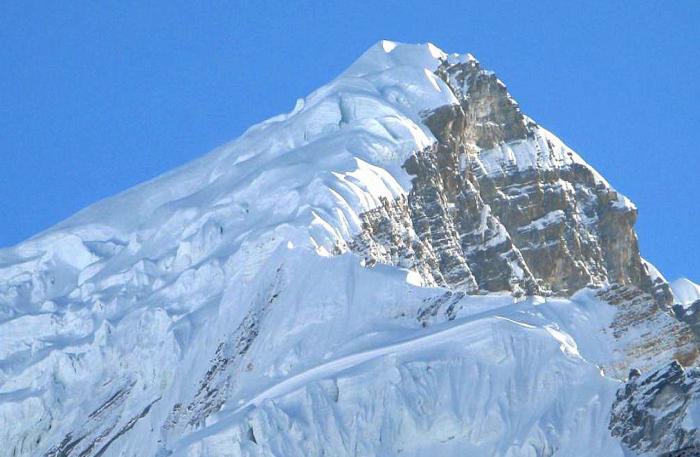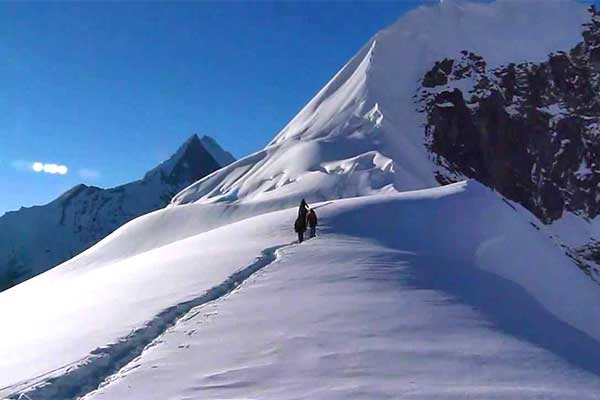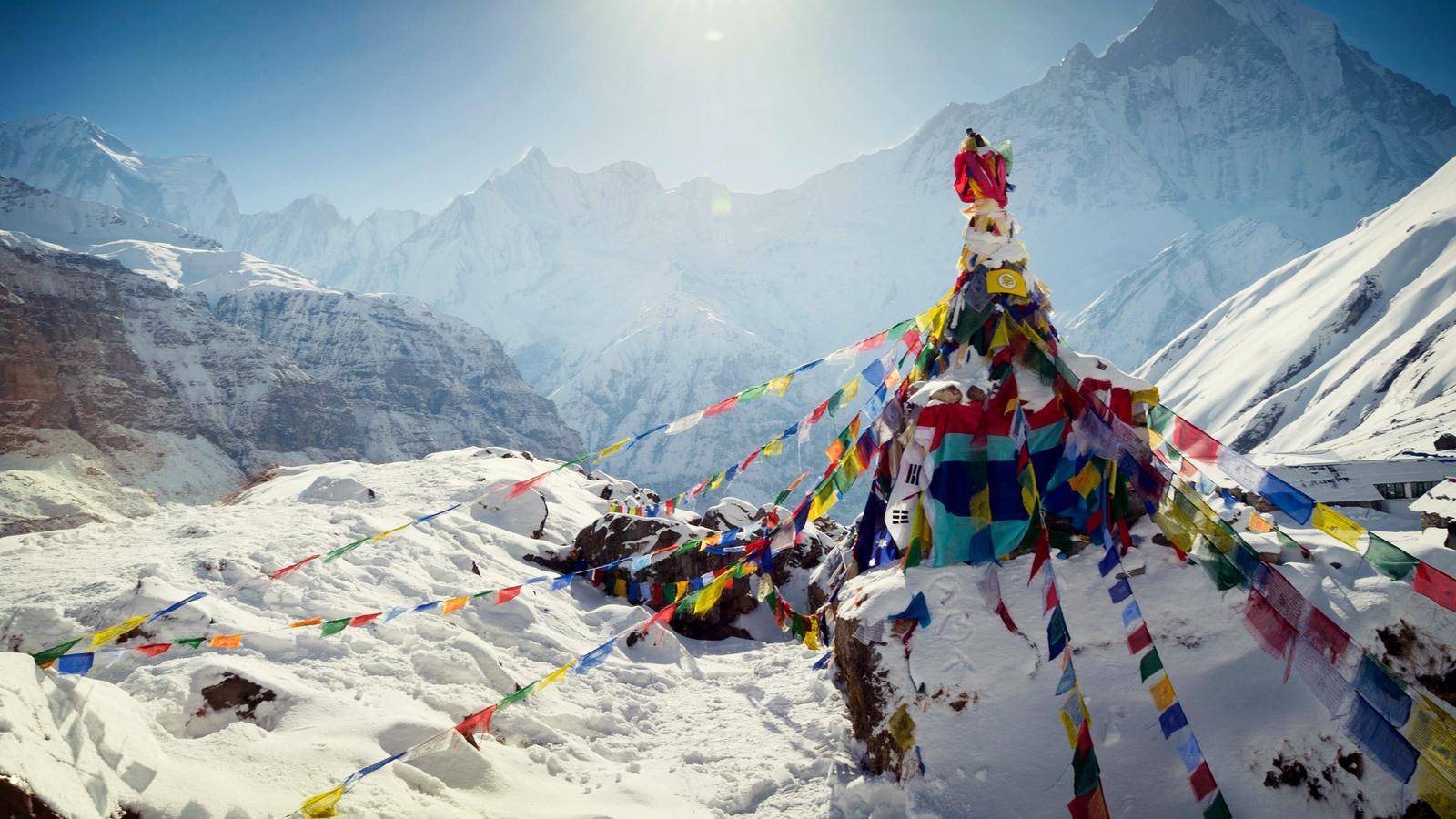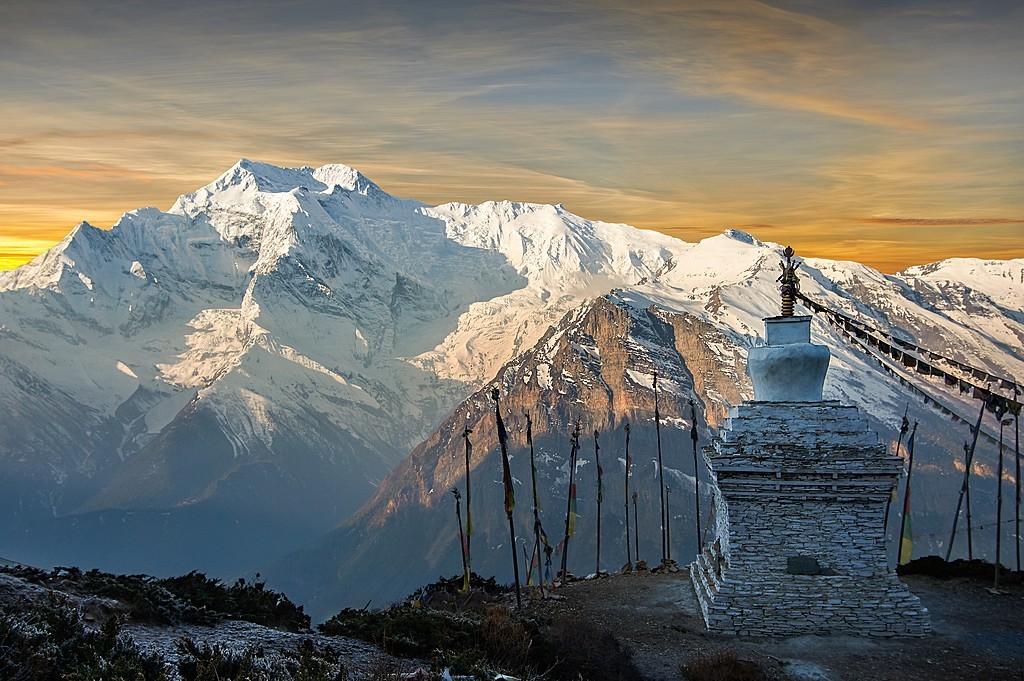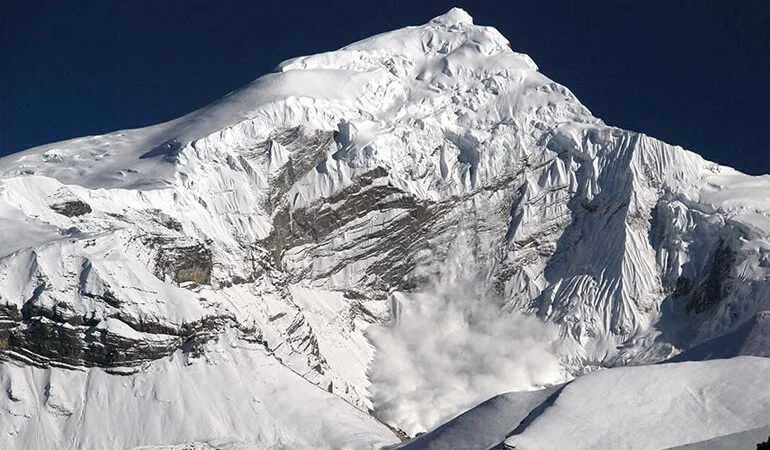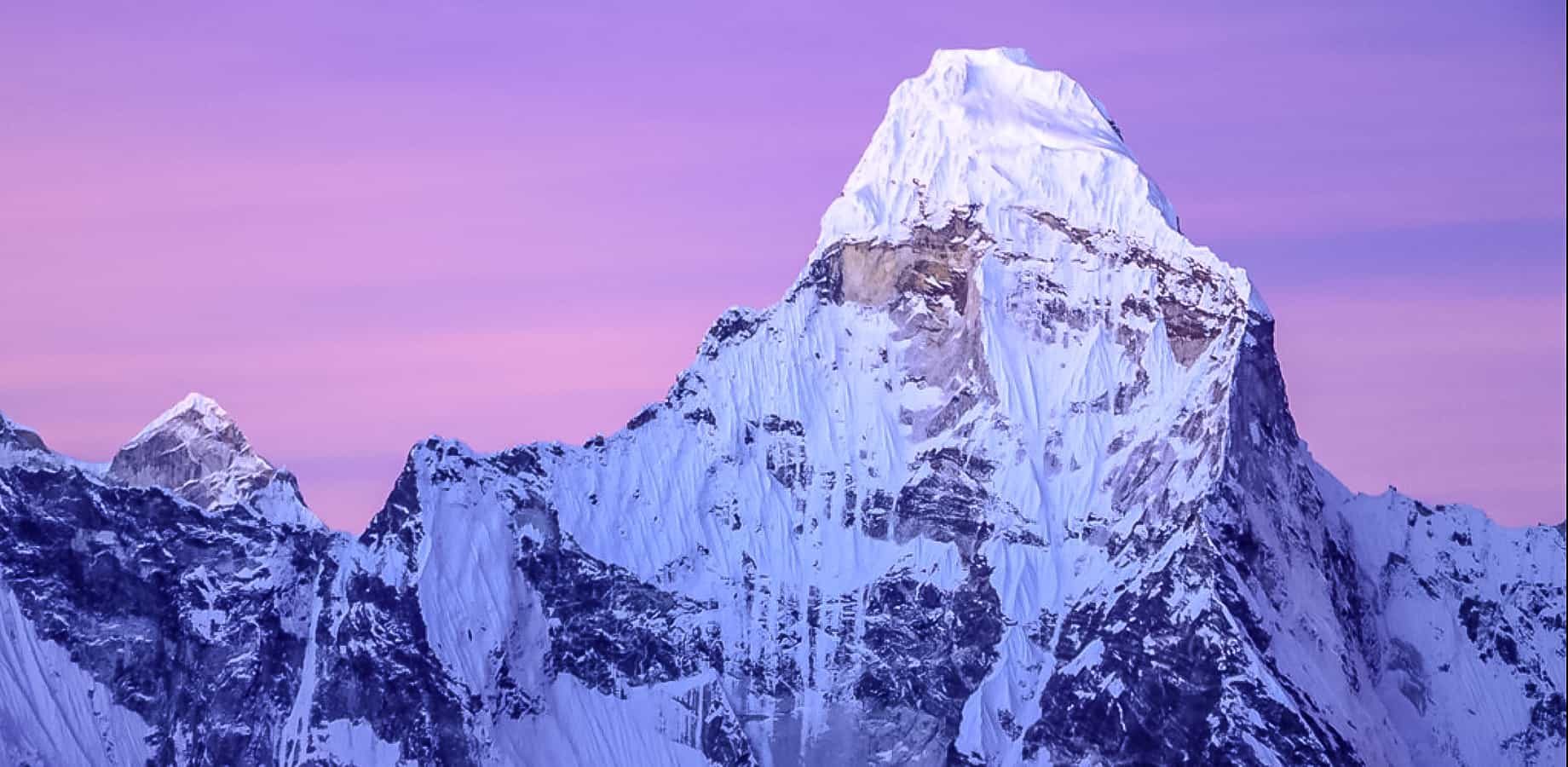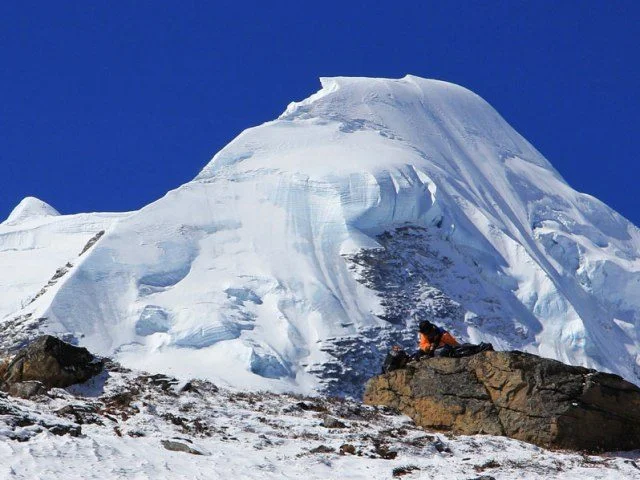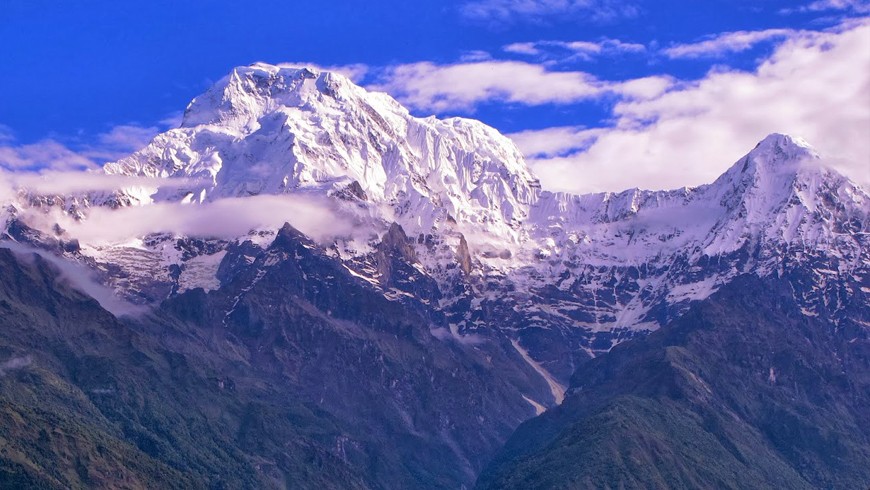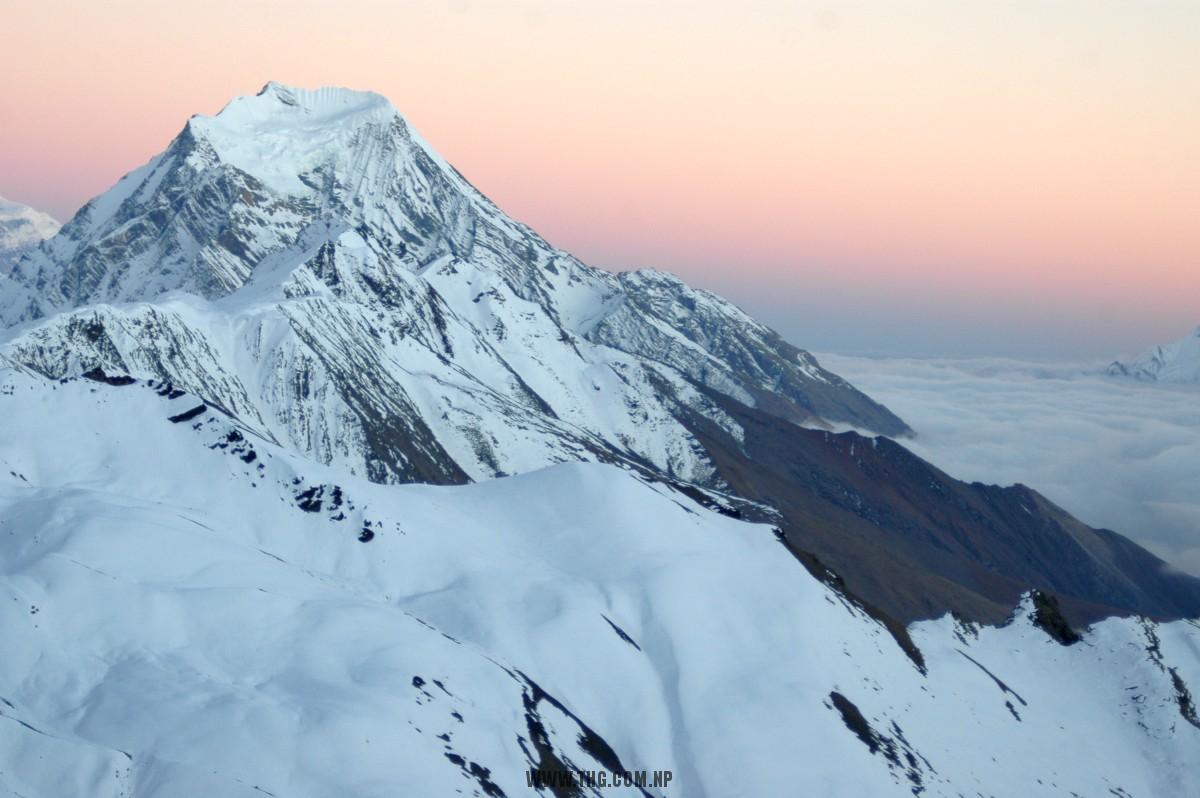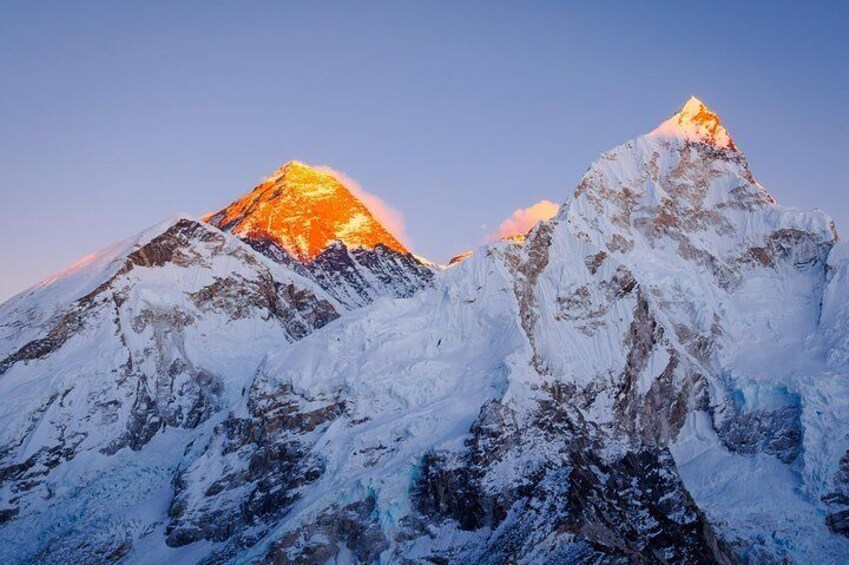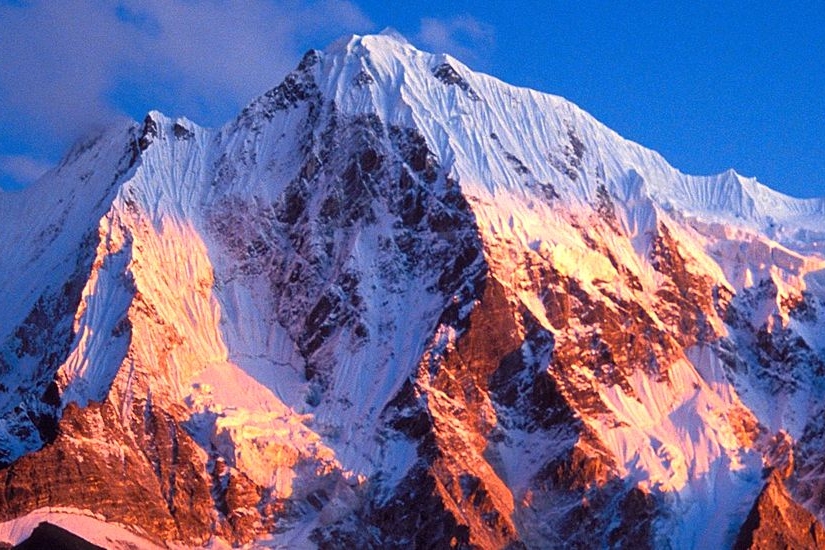Trip Facts
Highlights
- Climb Chulu West Peak (6,419m/ 21,058ft), and enjoy the most beautiful Himalayan views from the top
- Trek to Tilicho Lake – the world’s highest altitude lake
- Cross Thorang La Pass – the highest pass
- Indulge with 3600 dazzling close views of Annapurna range – Annapurna – I (8,091m/26,454ft), Mt. Machhapuchre (6,997m/22,956ft), BharhaChuli (7646m/25,085ft), GandharvaChuli (6,248m/20827), and more
- VisiMuktinath – one of the sacred Hindu-Buddhist temples
- Go to Marpha – the famous apple orchid village and local alcohol made of apples
- Enjoy Hot Spring at JhinuDanda (Hill)
- Well-experienced licensed guides, strong porters, and support crew members
- Physically less challenging journey and heavenly natural pleasure – Collect lifetime experiences
- One of the most satisfying expeditions in Nepal.
Overview
Lobuche west peak 6145m is one of the most famous trekking peaks in Everest region. There are two distinct summits to Lobuche peak: Lobuche east (6119 m) and Lobuche west (6145 m). Although they are connected by a continuous ridge there is a sharp gap and the considerable distance between the Lobuche west peaks is an e summit, offering a variety of existing routes and wide scope for new lines. Seen from near Pheriche, the dark triangle of its rocky east face rises above the moraines of the Khumbu Glacier to an icy skyline. This skyline forms the south ridges, the junction of the east faces with the glaciated southwest face and the line of the normal route of ascent.
This climb includes some technical difficulties on quite steep (45 – 50 degree) snow/ice slopes and requires the use of fixed ropes. The views of Ama Dablam and Taweche are spectacular. After the Lobuche Peak climbing, we continue towards Gorak Shep and climb to Kala Pattar (5545 m) from where we enjoy an impressive up-close view of Everest. Our return route passes through Tengboche, a magnificent location with a fascinating monastery, where we rest and savor the incredible scenery, including magnificent views of Everest, Ama Dablam (6856m), Kantega (6809m), Kwangde (6194m), Nuptse (7879m), and Lhotse (8511m), to name but a few Kusum kanguru peak climbig: Mount Kanguru (formally known as Kusum Kanguru) is a triple-summited mountain in the Khumbu Region of the Himalaya.
Itinenary
On your arrival at Kathmandu International Airport, you will be greeted with flowers in our traditional Nepalese way by our representatives from Nomadways Adventure then you will be transferred to the hotel.
We proceed to the major attractions of Kathmandu Valley which are all listed on the UNESCO World Heritage Site after breakfast. We will visit Boudhanath and Pashupatinath if we didn’t get the time to visit them the previous day. But if they were visited then we will cover Swoyambhunath Temple and one of the three Durbar Squares of the valley.
Swoyambhunath Stupa, also popular as the ‘monkey temple’ among foreign friends, is one of the oldest temples in the valley whose history is related to the formation of the valley itself. It is located on a hilltop in the center of Kathmandu and is seen from almost every corner. The stupa temple is worshipped by both Hindus and Buddhists. It is a great example of religious harmony in the country.
The three durbar squares in the three medieval cities in the Kathmandu Valley are equally beautiful and the numerous palaces, temples, and courtyards there openly display the combination of Hinduism, Buddhism, and Tantrism that characterizes Nepalese culture. All three durbar squares may appear to be the same for first timers but their history, value, arts, and details in craftsmanship interestingly vary.
Depending upon the time, we will visit one of these three durbar squares and return to Thamel. The remainder of the day is for trip preparation. You can purchase or rent any personal gear for the climb from the shops of Thamel.
We leave Kathmandu after breakfast and start the journey. Our today’s destination is Besisahar which can be reached in 6-7 hours by driving. Exiting Kathmandu, the environment seems clean and fresh. Our entire ride is charmed by the scenery of the hills, gushing Trishuli River till halfway, small settlements, terraced farms, and smiley locals. We will also take tea, lunch, and photography breaks en route. Once we reach Besisahar, we will check-in at the best available guest house and rest. In the evening, you can stroll around then purchase the necessities in case forgotten to get them in Kathmandu. The place also has a few ATMs where you can withdraw some cash that is enough for the trip. Also, take in the views of the mountains like Machhapuchhre, Annapurna II, and Lamjung Himal if the weather favors us.
We will catch the scheduled local sharing jeep in the morning and drive to Chame. We pass by many small settlements such as Bhulbhule, Bahundanda, Ghermu, Jagat, Chyamche, Tal, Dharapani, Timang, and Koto before arriving in Chame. The views along the route are wonderful alpine-like meadows, herds, pine forests, and some glimpses of snow-clad peaks. Once we are in Chame, we will rest in our guest house and spend the remainder of the day exploring the village and viewing the incredible Annapurna, Manaslu, and Lamjung Himal.
We wake up with incredible views of the mountains and have a hearty breakfast. We begin the trekking journey today. Leaving Chame village, we slowly start walking on the trail following the river. We walk by green fields before entering a dense pine forest. After an hour from Chame, we reach a village named Bhratang. The village has an apple farm, so some apple goodies or apple juice is a must-try here. After a short break, we resume the trek continuing on the trail on the cliffside that offers a view of snow-covered peaks, and reach our destination, Upper Pisang.
The traditional village of Upper Pisang has narrow lanes, stone houses, and some wooden buildings. Once we get there, we check in at the tea house and rest our legs. Later we will visit the monastery at the top of the village and take in the views of the surrounding villages and the mountains.
Today’s trek is much tougher than yesterday’s, but we will be rewarded with the most incredible views. We set off soon after our early breakfast with a stunning view of the Annapurna. After walking for a bit, we come across the mani walls inscribed with mantras where we will take a short halt. Then we move on and take a long, tough, and steep climb to the traditional village of Ghyaru which offers absolutely magical panoramic views of the mountains such as Annapurna, Pisang Peak, and others. From Ghyaru, we gently trek toward another settlement called Ngawal which is popular for a lunch break.
The views from the village are equally amazing. After lunch, we move slowly to Braga village with wonderful views accompanying us. We pay our visit to Braga Monastery, which is the largest in the Manang district, and move towards the Manang village, our destination of the day.
Today is needed acclimatization day. On this rest day, we will make a short walk to a higher elevation to Ice Lake (Kicho Tal) to get acclimatized. We start the hike after breakfast retracing the route to Braga. The path then climbs quickly, and we will be awarded a sweeping view of the mountains and Manang Village. As we continue, we will encounter the zigzag trail and slippery trial. We will pass by a small tea house en route and after 3 hours of starting, we reach the Ice Lake.
We eat our lunch at the bank of the lake looking at the wonderful lake and the mountain vistas surrounding us. You can click as many photos as you want and we will return back to Manang for the night.
Departing Manang village after breakfast, we hit the trail again and moved toward the checkpoint where our permits were examined and stamped. The route wound its way out of Manang, and we will quickly ascend above the settlement. You have the time to take in the stunning views of the mountains, the river winding through the valley, and the distant lake. We may encounter loaded mule trains and mountain yaks grazing at the side of the path. We reach Ghunsang and take a short break.
The trail then goes uphill and winds up while offering breathtaking vistas of distant mountains covered in snow. There are the normal ups and downs and the walk to Yak Kharka is fairly easy. From here, we will cross a couple of suspension bridges while enjoying some of the nicest mountain vistas. We will reach Yak Kharka where we will eat our lunch. Many people decide to stay the night in order to adhere to the suggested 500m elevation gain each day.
But we walk further to Letdar, which is only a few hundred meters higher. We once again come across a lengthy suspension bridge before reaching Letdar. The remainder of the day is for resting.
Today we will trek to the Chulu West Base Camp after breakfast in Letdar. Despite the difficulty of increasing altitude, we go forward on a pleasant and calm trip through stunning surroundings. When we get to the base camp, we set up camp and have some free time to explore the area to acclimate. The base camp offers a fantastic view of the Annapurna ranges.
Today’s route from the base camp to the high camp is not that technical where we will enjoy more breathtaking vistas as we ascend. The peaks such as Annapurna ranges, Dhaulagiri, Manaslu, Gangapurna, and Lamjung Himal accompany us in our walk.
Rest day at the high camp to get acclimatized. If you are interested to explore, then you can stroll around the High Camp.
The most awaited day has come today. It will be a long and daring day since you’re going to climb Chulu West Peak. We will begin early, before dawn, and start ascending gently on the icy trail. Once the sun has come out completely, we will get to enjoy alluring breathtaking views of the Himalayas. We use ropes, crampons, and an ice axe to reach the top of the peak. The feeling of joy and triumph, accomplishment and success of being at the Chulu West Peak Summit combined with the magnificent and expansive view of the mountains, including Annapurna II, Annapurna IV, Gaganpurna Peak, and Lamjung Peak, is exceptional. Once we’ve captured these lovely moments, we will gently make our way back to base camp.
This is a contingency day if we are unable to make the climb to the peak the other day because of unfavorable weather or other reasons. It is not required if we successfully climbed the peak.
We tidy up the base camp today and depart for Thorong Phedi. Retracing our steps along the trail that lead to Letder and then head north toward the difficult pass. We cross numerous tiny streams that come from the Chulu East and Chulu West peaks. We will also pass through some regions that are vulnerable to landslides and a few sparsely spaced tea shops. We will arrive at the base of the Thorong Phedi Pass after around a six-hour hike. You can choose to hike further up to the High Camp depending on your level of fitness and your interests.
Today we will be making an attempt to cross the Thorang-La Pass, one of the world’s highest navigable crossings at 5416 meters. We start very early in the morning before sunrise on the zigzag trail to the mountain. After 1.5 – 2hrs, we reach the High Camp where we will make a brief break before beginning the last ascent to Thorong-La. As the sun begins to peep above the mountains the views start to unfold in front of our eyes. As we keep going, we will abruptly turn over a short hill and notice a large number of prayer flags indicating we are at the Thorong-La Pass. We will be rewarded with breathtaking views of the Annapurna, Gangapurna, and the eye-catching peak of Khatungkang after we arrive at Thorong La Pass.
After enjoying the time at the pass, it is time to descend through the zigzagged path. Making a few stops to rest as well as enjoy the views, and making a long and arduous descent, we finally reach Muktinath.
We visit Muktinath Temple in the morning and start the journey to Jomsom after breakfast. We bid goodbye to Muktinath and set off on a trail through small villages avoiding the motorable road. For the first hour, we will through farms and terraces, cross mountain streams, and join a tarmac road after a while, which we will continue to travel along for some time. We will continue till we reach Kagbeni, which was surrounded by mountains and farms. We will visit the Kag Chode Thupten Samphel Ling Monastery in the heart of the hamlet. Then, we keep strolling around the traditional Kagbeni village, navigating the labyrinthine lanes lined with stone buildings, little archways, and even erotic statues for a while. Then after lunch, we resume our trekking towards Jomsom along the dry riverbed.
After breakfast, we check into the airport for our 30-minute thrilling flight back to Pokhara between the gorges of the two enormous mountains, Annapurna and Dhaulagiri. Once we check in at the hotel and drop off our bags, we will spend the remaining afternoon leisurely exploring the stunning Pokhara valley. We will boat at the Fewa Lake, the second largest lake in Nepal where we will admire the reflection of Machhapuchhre (Fishtail) peak in the lake.
We will also visit the Tal Barahi temple in the center of the lake. From the shore of the lake, you can opt. to hike for an hour to the World Peace Pagoda through the forest, or boat back to the starting line and explore other attractions such as Davis Falls, and Gupteshwor Mahadev Cave, Mahendra Cave, etc. We will spend the evening wandering along the lakeshore.
We leave the lovely Pokhara valley and travel to Kathmandu after breakfast. We travel through rural villages, landscapes, winding roads, green hills, small but lovely waterfalls, torrential rivers like Trishuli and Marshyangdi, as well as the distant view of enormous mountains that tower over the trail.
Once in Kathmandu, take some time to relax in your hotel. Later you can explore this energetic city and shop for souvenirs and mementos to bring home. This evening is set aside for a farewell dinner with Nomadways Adventure in an authentic Nepalese restaurant where we will be served authentic Nepalese cuisine and a cultural program
The Chulu West Peak Climbing trip ends here. You will be transferred to the airport 3 hours before your scheduled flight to your home or onward destination. We wish you a safe and relaxing journey ahead!
Cost Includes:
- All airport transfers
- Luxury Hotel in Kathmandu for two nights with breakfast
- All airport taxes
- All necessary paperwork and trekking permits (National Park permit and TIMS)
- An experienced English-speaking Govt. registered trekking guide and local porters to carry luggage (2 trekkers: 1 porter)
- Full meals: Breakfast, Lunch & Dinner of your choice
- Supplementary snacks: energy bar and cookies
- Seasonal fresh fruits desert every day
- Unlimited Chlorine treated Safe Drinking water
- A comprehensive First Aid kit
- Oxi-meter: To check heart rating and oxygen saturation to Everest Base Camp and return
- All government and local taxes
- Trekking equipment: down-filled sleeping bag, walking poles, and duffel bag
- Souvenir: Trekking Route map printed T-Shirts
Cost Excludes:
- Lunch and dinner in Kathmandu
- Hot and bottled drinks
- Electronic device re-charge Wi-Fi
- Hot shower
- Travel insurance and medical evacuation
- Tipping
Equipment
Trekking requires careful selection of gear to ensure comfort, safety, and efficiency on the trail. Depending on the conditions (terrain, weather, duration), the equipment you need may vary, but here’s a comprehensive list of essential trekking gear:
- Backpack
- Capacity: Typically, for a multi-day trek, a 40-60L pack is ideal.
- Fit: Adjustable straps for shoulder, chest, and hip.
- Features: Hydration system compatibility, side pockets for easy access, and a rain cover.
- Footwear
- Trekking Boots: Look for boots with good ankle support, durable soles (Vibram is a popular choice), and waterproof features.
- Trail Shoes: For lighter treks or well-maintained paths, trail shoes may suffice.
- Sock Layers: Merino wool socks or synthetic socks that wick moisture and reduce blisters. Avoid cotton.
- Gaiters: To keep debris, mud, and snow out of your boots.
- Clothing (Layering System)
- Base Layer: Moisture-wicking (synthetic or merino wool) long-sleeve top and bottoms.
- Mid Layer: Insulating layer, such as a fleece or down jacket.
- Outer Layer (Shell): Waterproof, windproof jacket and pants. Gore-Tex or similar fabrics are excellent choices.
- Trekking Pants: Convertible pants (with zippers for shorts) can be useful.
- Trekking Shirt: Lightweight, moisture-wicking, and quick-drying.
- Gloves: Lightweight gloves for warmth, plus an additional heavier pair if trekking in cold climates.
- Hat/Cap: A sunhat or beanie depending on the weather.
- Neck Gaiter/Buff: For sun protection, warmth, or dust.
- Sleeping Gear
- Sleeping Bag: Temperature-rated for the conditions you’ll face. Down bags are warmer and lighter but lose effectiveness if wet, while synthetic bags dry quicker.
- Sleeping Pad: Inflatable or foam pads that insulate from the cold ground.
- Tent: Lightweight trekking tents (1-3 person) that suit your conditions. Some options include 4-season tents if you're trekking in harsh weather.
- Hydration System
- Water Bottles: Collapsible or hard plastic bottles (ensure they’re BPA-free).
- Hydration Reservoir: Camelbak or similar bladder systems for easy access to water.
- Water Purification: A filtration system (e.g., Sawyer, LifeStraw) or chemical tablets to purify water from streams or other sources.
- Food and Cooking
- Stove: Compact gas or alcohol stove for cooking on the trail.
- Cookware: Lightweight pots or pans, often titanium or aluminum.
- Fuel: Compatible fuel for your stove (check for availability in the region you’re trekking).
- Food: Dehydrated meals, energy bars, trail mix, nuts, and fruits. Lightweight, high-calorie, and easy-to-prepare foods are best.
- Navigation Tools
- Map and Compass: Always have a paper map as a backup, even if you use a GPS.
- GPS Device or Smartphone with a Trekking App: Make sure to download offline maps.
- Altimeter Watch (optional): Useful for tracking elevation and route progress.
- Lighting
- Headlamp: Hands-free lighting for night-time use, with extra batteries.
- Flashlight: A backup to your headlamp.
- First Aid Kit
- Include basic supplies: Bandages, antiseptic wipes, blister treatment, pain relievers, and any personal medications.
- Personal Medications: Always bring enough for the whole trip, plus extras in case of delays.
- Sunscreen and Lip Balm: Protect your skin from sun exposure.
- Safety Gear
- Multi-tool/Knife: A good multi-tool (like a Swiss Army Knife or Leatherman) is very useful for repairs and emergencies.
- Whistle: For signaling.
- Emergency Blanket: Lightweight and compact for warmth in case of emergency.
- Firestarter: Matches or a lighter, and waterproof if needed.
- Miscellaneous
- Trekking Poles: Help with balance, reduce strain on knees, and improve traction on uneven terrain.
- Towel: Quick-dry, compact towel.
- Sunglasses: UV protection for your eyes.
- Camera/Smartphone: For documenting the journey, with extra storage or a portable charger.
- Personal Hygiene and Toiletries
- Toilet Paper: Always carry biodegradable toilet paper and a small trowel for digging a "cathole" if there are no facilities.
- Hand Sanitizer: To keep clean without access to water.
- Wet Wipes: For cleaning yourself when there's no shower.
- Biodegradable Soap: If you need to wash, use eco-friendly soap.
- Toothbrush/Toothpaste: Compact travel versions.
- Weather Protection
- Sun Protection: Sunglasses, sunblock, and a wide-brimmed hat for sun protection.
- Rain Gear: A high-quality waterproof jacket, pants, and gaiters, especially if you're trekking in areas with unpredictable weather.
- Cold Weather Gear (if needed): Depending on the trek, you might need additional gear like down jackets, insulated gloves, or even crampons for ice or snow.
- High-altitude Treks: Consider gear for altitude sickness (like Diamox), extra layers for extreme cold, and an oxygen system if necessary.
- Long-distance Treks: You might need additional gear like extra food storage, a larger stove, or a lightweight trekking umbrella.
FAQ's
Chulu West Peak (6,419m/21,059ft) is classified as a trekking peak, but it requires technical climbing skills, physical fitness, and experience in high-altitude trekking. Participants should have prior experience with ice axes, crampons, and rope climbing.
The best seasons are Spring (March-May) and Autumn (September-November). These months offer stable weather, clear skies, and favorable conditions for climbing and trekking.
Yes, prior trekking and mountaineering experience is highly recommended. You should be familiar with basic climbing techniques and equipment like crampons, harnesses, and ropes. If you’re a beginner, completing a basic mountaineering course is advised.
Climbers should have a high level of physical fitness and endurance. The expedition involves long days of trekking and climbing at high altitudes. A good regimen of cardio, strength training, and hiking preparation is crucial.
